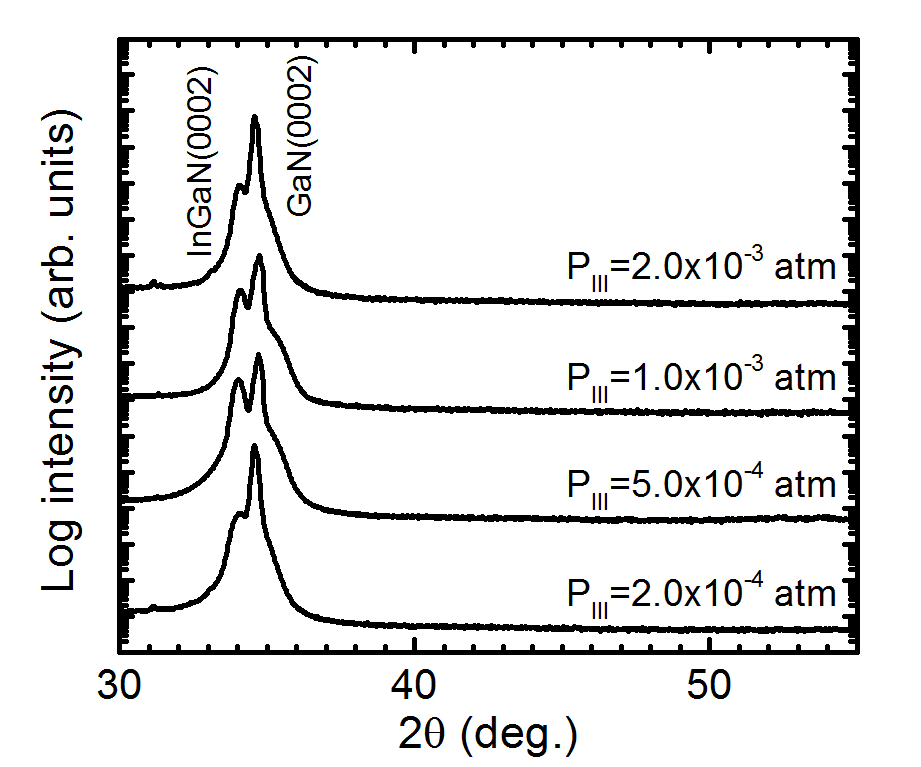| Search for content and authors |
Growth of thick InGaN by Hydride Vapor Phase Epitaxy |
| Takahide Hirasaki , Masato Ishikawa , Hisashi Murakami , Yoshinao Kumagai , Akinori Koukitu |
|
Tokyo University of Agriculture and Technology, Department of Applied Chemistry (TUAT), 2-24-16 Naka-cho, Koganei, Tokyo, Japan, Tokyo 184-8588, Japan |
| Abstract |
InGaN ternary alloys are exhaustively investigated as potential materials for high efficiency optical devices such as light-emitting diodes (LEDs) and laser-diodes (LDs) operated from infrared (IR) to ultraviolet (UV) spectrum range. Generally, MOVPE growth is employed to grow InGaN layer on GaN layer. It is well known that high efficiency of LEDs using InGaN is realized at blue spectrum region and the luminous efficiency decreases with increasing emitting wavelengths. This is because the degradation of crystalline quality is caused by increasing the In composition. In addition, it is difficult to obtain compositional uniform InGaN layer with high In content due to its compositional unstable nature in MOVPE [1]. Therefore, it is essential to fabricate a high crystalline quality thick InGaN layer and to use it as initial substrate for InGaN-related devices. On the other hand, it is expected that hydride vapor phase epitaxy (HVPE) can control In composition over entire compositional range without inhomogeneity and grow InGaN thick layer due to its high free energy change of the formation [2]. In this work, the growth of InGaN by HVPE was investigated. InGaN epitaxial layers were grown by a horizontal atmospheric-pressure HVPE system. C-plane freestanding GaN substrate was used as an initial substrate. N2 was used as a carrier gas. InCl3 and GaCl3 were used as the group III source precursors, which were generated by the reactions between metallic Ga and In, and Cl2 in the upstream region of the reactor [3]. NH3 was mixed with the group-III precursors at deposition zone. InGaN grown layers were characterized by X-ray diffraction (XRD), scanning electron microscopy (SEM) and photoluminescence (PL) measurements. Figure 1 shows 2θ-ω mode XRD profiles of InGaN grown on GaN substrate at various group-III input partial pressures. It is clear that InGaN layers can be epitaxially grown on GaN substrate without metal droplet under all growth conditions. Though the input concentration of the group-III was changed, In solid composition was kept constant approximately at 0.15, where In solid composition of grown InGaN layer was estimated by (0002) peak in XRD 2θ-ω measurement using vegard’s low. Figure 2 shows the dependence of growth rate as a function of group-III input partial pressure. The growth rate of InGaN linearly increases with increasing the group-III input partial pressure. These results imply that InGaN growth is limited by the mass-transport of precursors under these conditions. The growth rate of 15.6 μm/h was obtained in this growth system, which was over hundred times faster than that by MOVPE. 
Figure 1 2θ-ω mode XRD of InGaN layers grown on GaN substrate at various group-III input partial pressures
Figure 2 Dependence of growth rate on group-III input partial pressureReference [1] A. Koukitu and H. Seki, J. Cryst. Growth, 189/190 (1998) 13-18. [2] Y. Kumagai et al., J. Cryst. Growth, 231 (2001) 57-67. [3] K. Hanaoka et al., J. Cryst. Growth, 318 (2012) 441-445. |
| Legal notice |
|
| Related papers |
Presentation: Poster at 17th International Conference on Crystal Growth and Epitaxy - ICCGE-17, Topical Session 3, by Takahide HirasakiSee On-line Journal of 17th International Conference on Crystal Growth and Epitaxy - ICCGE-17 Submitted: 2013-04-15 06:08 Revised: 2013-07-26 12:26 |